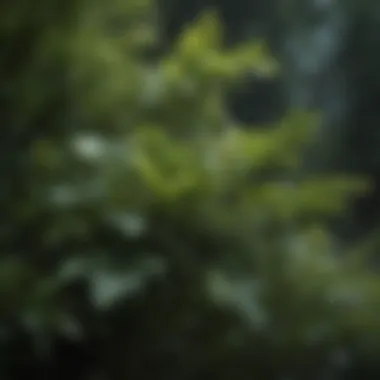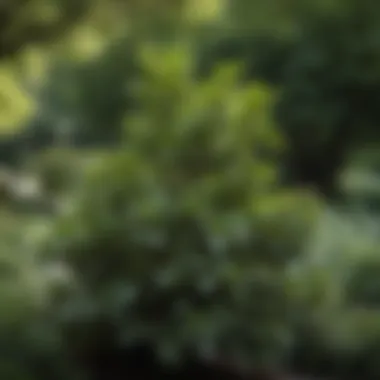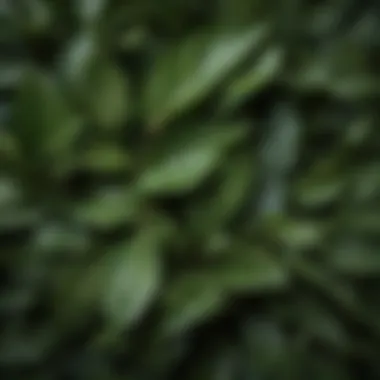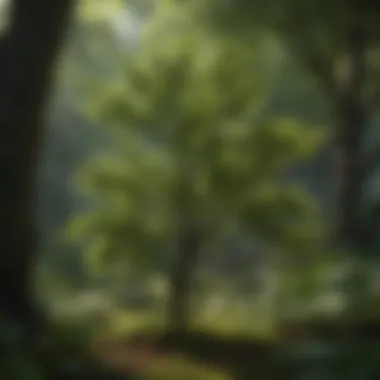Exploring Cherry Laurel Shrubs: Characteristics and Care


Intro
Cherry laurel shrubs, known for their lush and dense foliage, serve not only as beautiful additions to landscapes but also play a critical role in the environment. Understanding the botanical characteristics of these shrubs is essential for anyone interested in gardening, landscaping, and ecological preservation. This exploration will encompass the key attributes of cherry laurel, their care, ecological impacts, and best practices for sustainable management.
Characteristics of Cherry Laurel Shrubs
Cherry laurel, scientifically referred to as Prunus laurocerasus, is an evergreen shrub that can vary greatly in size and shape. Typically, these shrubs can grow up to 10 to 15 feet in height, although certain cultivars may reach even higher. The leaves are glossy, dark green, and lance-shaped, making them appealing in various landscape designs. The flowers are small and white, often appearing in clusters, and they develop into dark purple or black berries, which can attract wildlife but are toxic to humans.
Uses in Landscaping
Cherry laurels are frequently utilized in hedges, borders, and privacy screens due to their dense foliage. Their ability to thrive in both sunny and shaded locations adds to their versatility. Gardeners often appreciate how quickly they establish themselves, making them a practical choice for instant green cover. Furthermore, they can be pruned to maintain size and shape, allowing for creative landscape designs.
Care and Maintenance
Caring for cherry laurel shrubs requires awareness of their needs and potential issues. They are generally low-maintenance but can benefit from regular pruning and monitoring for pests. A well-drained soil with rich organic matter is ideal for these shrubs. Watering should be consistent, especially during dry spells.
Common Pests and Diseases
While cherry laurels are hardy, they can be susceptible to issues like aphids or fungal diseases in cases of high humidity. Early detection and treatment are important to ensure their health. Practices such as ensuring good air circulation and avoiding overhead watering can mitigate these risks.
Ecological Impact
Exploring the ecological effects of cherry laurel is a crucial part of understanding their role in landscapes. They can serve as a habitat for various birds and insects, contributing positively to biodiversity. However, there are also concerns regarding their invasive potential in certain regions, as they can outcompete native species for resources.
Sustainable Management Practices
An effective approach to sustainable management of cherry laurel includes careful monitoring and controlling of their spread. Planting them in controlled environments and regularly assessing their impact on local ecosystems is key. Engaging in community-oriented projects to promote native plant species can also help maintain a balance in local biodiversity.
Closure
Cherry laurel shrubs present both opportunities and challenges in gardening and environmental management. By understanding their characteristics and needs, individuals can make informed decisions that benefit their landscapes and support ecological health. The knowledge gained through this exploration can empower gardeners, landscape architects, and environmental enthusiasts to appreciate the delicate balance between beauty and sustainability in nature.
Prelims to Cherry Laurel Shrubs
Cherry laurel shrubs have gained recognition in the landscaping world for their adaptability and dense foliage. This article explores their various features, cultivation needs, and ecological implications. By understanding cherry laurel, readers will appreciate its roles in both horticulture and environmental conversations.
Overview of Cherry Laurel
Cherry laurel, scientifically known as Prunus laurocerasus, is an evergreen shrub that is often used in gardens and parks. Its glossy leaves provide continuous visual interest throughout different seasons. The shrubs can grow tall and wide, making them suitable for various landscaping purposes. Available in different cultivars, cherry laurel can meet diverse aesthetic and practical needs. Furthermore, its growth habits create privacy and noise barriers, adding to its value in urban design. Many thrust it as a reliable choice for low-maintenance gardens due to its resilience once established.
Botanical Classification
Understanding the botanical classification of cherry laurel offers a clearer perception of its characteristics. The cherry laurel belongs to the Rosaceae family, which also includes other well-known species such as cherries and almond trees. It is classified under the genus Prunus, which encompasses many fruit-bearing and ornamental plants. This classification is essential for horticulturists and garden planners, as it informs them about similar species, potential pests, and diseases. The taxonomy of cherry laurel reminds gardeners of its relationship with other plants, creating a comprehensive knowledge base for effective cultivation and maintenance.
"Distinctive botanical classifications provide insightful patterns that guide sustainable gardening practices."
Physical Characteristics
The physical characteristics of cherry laurel shrubs play a crucial role in understanding their utility in landscape design and ecological contributions. These attributes, including growth pattern, size, foliage, and flower production, determine how well these plants can fit into specific environments. They also influence decisions about their maintenance and care. Thus, a careful examination of these aspects offers valuable insights for both horticulturists and environmentalists.
Growth Habit and Size


Cherry laurel shrubs typically exhibit a dense and bushy growth habit, making them suitable for various landscaping applications. These shrubs can reach heights of up to 10 to 20 feet, which can vary depending on the specific variety and growing conditions. The width is also substantial, often spanning up to 10 feet or more. This growth form allows them to function effectively as privacy screens or windbreaks.
When planning a garden or landscape, understanding the space available is essential. The size of cherry laurel means it can serve multiple purposes, from creating secluded areas to acting as natural barriers against wind and noise. Additionally, the compactness of their growth habit provides ease of maintenance, particularly when shaping them into hedges. Regular pruning helps keep them at desired heights, but it's essential to consider their overall size before planting to avoid overcrowding.
Foliage and Flowers
The foliage of cherry laurel is one of its most distinctive features. The leaves are typically evergreen, with a glossy, dark green appearance that lends a lush look year-round. This evergreen characteristic enables the shrub to provide continuous cover, which enhances the visual appeal of landscapes through all seasons. The leaves are lance-shaped, measuring about 3 to 5 inches long, and have a leathery texture that can withstand various weather conditions.
In early spring, cherry laurel produces small, white, fragrant flowers, which appear in upright clusters called racemes. These delicate flowers attract various pollinators, including bees and butterflies, adding an ecological benefit to gardening. However, while the flowers are attractive, they can also lead to fruit development, which merits further discussion.
Fruit Production
Following the flowering phase, cherry laurel shrubs produce small, dark berries. These drupes are typically around one-quarter inch in diameter and mature to a deep purple or black color by late summer. While they may seem appealing, it is important to note that the fruit contains cyanogenic compounds. These compounds can be toxic if ingested in significant quantities. Despite this, some species of birds feed on the berries without harm, thus playing an essential role in local food chains.
The production of berries can contribute to the overall biodiversity in the area, attracting various wildlife. However, gardeners should evaluate their surroundings and consider the potential for these shrubs to self-seed in unmanaged areas, which can lead to ecological concerns. Understanding the fruiting characteristics of cherry laurel is crucial for sustainable management and landscape planning, ensuring a balance between aesthetic appeal and ecological integrity.
Cultivation Requirements
Understanding the cultivation requirements of cherry laurel shrubs is essential for anyone interested in maintaining healthy plants. Proper care ensures optimal growth and vibrant foliage, contributing to the aesthetic and ecological purposes these shrubs serve. To effectively cultivate cherry laurels, one must pay attention to soil preferences, light and water needs, and temperature conditions.
Soil Preferences
Cherry laurel shrubs thrive in well-drained soils with a good amount of organic matter. They prefer acidic to neutral pH levels, ideally between 6.0 and 7.0. The addition of compost can enhance soil quality, providing the necessary nutrients that promote healthy growth.
- Well-drained soil: Essential to prevent root rot and other diseases.
- Organic matter: Improves soil structure and fertility, fostering growth.
- pH levels: Ideal range is between 6.0 and 7.0, aiding nutrient availability.
These conditions help create an environment where cherry laurels can flourish and become robust plants in landscaping setups.
Light and Water Needs
Light and water supply are crucial factors in maintaining cherry laurel shrubs. They generally require partial to full sun but can tolerate some shade. However, under excessive shade, their growth may stunt, leading to sparse foliage and weakened structure. Watering should be consistent, particularly during dry periods.
- Sun Exposure: Cherry laurels prefer at least four to six hours of sunlight daily.
- Shade Tolerance: They can survive in partial shade but risk reduced vitality.
- Watering: Regular watering is important to prevent stress; however, overwatering should be avoided.
By managing light and water effectively, gardeners can enhance the health and growth of cherry laurels.
Temperature and Hardiness Zones
Cherry laurel shrubs are known for their hardiness, with the ability to withstand varying temperature extremes. They can typically adapt to hardiness zones ranging from 5 to 9. It is important to note their capability to endure cold winters but also their need for protection from extremely hot climates.
- Hardiness Zones: Zones 5 to 9 allows for a broad geographical range.
- Winter Resilience: Able to survive cold temperatures but should be monitored for signs of frost damage.
- Heat Sensitivity: Can struggle in areas with high heat; it’s best to provide some shade in such regions.
By considering temperature and the right hardiness zones, growers can ensure successful cultivation of cherry laurel shrubs, maximizing their landscape potential.
"Proper cultivation greatly impacts the longevity and appearance of cherry laurel shrubs." - Landscape Professional
Maintaining cherry laurel shrubs requires understanding these cultivation principles. Effective management of soil, light, water, and temperature leads to healthier plants. With the right approach, cherry laurel can be an admirable addition to any garden or landscaped area.
Uses of Cherry Laurel in Landscaping
Cherry laurel shrubs are increasingly popular in landscaping due to their versatile nature. They bring numerous benefits to gardens and green spaces. Understanding their uses can help gardeners, landscape architects, and environmentalists appreciate their full potential. Each application has its unique advantages that align with both aesthetic and ecological considerations.


Privacy Screens and Hedges
Cherry laurels are commonly employed as privacy screens and hedges. Their dense foliage forms a natural barrier, providing seclusion in both residential and public spaces. When planted in a row, these shrubs create a solid green wall that effectively blocks views and noise.
To maximize their effectiveness as hedges, it's essential to consider spacing and planting techniques. Planting them approximately 3 to 5 feet apart allows them to grow together into a seamless hedge. Regular pruning aids in maintaining desired height and fullness.
The benefits of cherry laurel hedges extend beyond privacy. They provide shelter for local wildlife and create a microhabitat conducive to biodiversity. Proper landscaping with cherry laurel can also enhance property value.
Erosion Control
Another practical use of cherry laurel shrubs is for erosion control. Their extensive root systems help anchor soil in place, preventing it from being washed away during heavy rainfall or strong winds. This is particularly valuable in sloped areas where soil stability is often a concern.
Planting cherry laurels on embankments or near water bodies can significantly reduce the risk of soil erosion. Furthermore, their ability to thrive in various soil conditions makes them suitable in diverse landscapes. By integrating cherry laurels into landscape design in vulnerable areas, one can create more resilient habitats and single out erosion issues effectively.
Aesthetic Appeal
In addition to their practical applications, cherry laurel shrubs are visually striking. Their lush, evergreen leaves provide year-round color and can enhance the overall look of any garden. The glossy foliage and delicate white flowers in spring show off their ornamental qualities.
When used in landscape design, cherry laurels can complement a variety of architecture styles. They can soften hard lines or fill spaces between other plants. Additionally, the modifiable nature of these shrubs allows for creative possibilities, whether they are used in mix-border plantings or as stand-alone features.
Integrating cherry laurels with other plants can also promote seasonal interest. Combining them with flowering plants can offer color variety throughout the year. This multilayered approach in landscaping creates dynamic environments that appeal to a wide audience.
The versatility of cherry laurel in landscaping makes it an ideal choice for both functional and aesthetic applications.
Engaging creatively with cherry laurel can result in a garden space that is not only beautiful but also serves practical purposes. The thoughtful application of these shrubs enriches any landscape, making them a valuable asset in gardening and environmental initiatives.
Maintenance and Care
The maintenance and care of cherry laurel shrubs are crucial for ensuring their health and longevity. Proper care practices not only keep these plants looking vibrant but also enhance their resilience against pests and diseases. Understanding the specific needs of cherry laurels can lead to thriving specimens that contribute positively to landscapes.
Pruning Techniques
Pruning is an essential part of cherry laurel care. It helps maintain the desired shape and size, encourages healthy growth, and improves air circulation within the foliage.
To achieve optimal results:
- Timing: Pruning should be done in late winter or early spring before the new growth begins. Avoid heavy pruning in fall to prevent stimulating new growth that can be damaged in winter.
- Method: Use clean, sharp tools for cutting. Remove dead, damaged, or crossing branches first. Then, shape the shrub as needed, taking care to avoid excessive reduction of the foliage. This ensures the plant can still produce energy through photosynthesis.
- Frequency: Depending on the growth rate and purpose of the shrub, annual pruning may be necessary. However, periodic light trimming can help maintain shape without over-stressing the plant.
Pest and Disease Management
Cherry laurel shrubs can be susceptible to various pests and diseases, which can lead to significant health problems if not managed effectively. Regular monitoring is essential to catch issues early.
Some common pests include:
- Aphids
- Scale insects
- Spider mites
Effective management involves:
- Cultural Practices: Ensure adequate spacing between plants to improve air circulation. This reduces humidity and discourages many pests.
- Biological Control: Encourage natural predators such as ladybugs for aphid control. This can help maintain a balance in the ecosystem.
- Chemical Control: If infestations occur, consider using insecticidal soaps or horticultural oils. Always follow label instructions and avoid applications during blooming to protect pollinators.
Regular inspections can help identify symptoms of diseases like leaf spot and root rot. Corrective measures should be taken promptly, which may include fungicides or adjusting watering practices to ensure proper drainage.


Nutritional Needs
Proper nutrition is vital for cherry laurel shrubs to thrive. A balanced approach to fertilization can promote lush foliage and vibrant growth.
- Soil Testing: Conduct soil tests to determine the pH and nutrient levels. Cherry laurels prefer slightly acidic to neutral soils (pH 6.0 - 7.0). Adjust soil amendments accordingly based on test results.
- Type of Fertilizer: A slow-release fertilizer formulated for shrubs can provide necessary nutrients over time. Look for fertilizers high in nitrogen and balanced with phosphorus and potassium.
- Application: Fertilizing in early spring as new growth appears encourages robust foliage development. Avoid over-fertilization, which can lead to excessive growth susceptible to pests and water stress.
Regular maintenance and care practices will ensure your cherry laurel shrubs remain healthy, enhancing both their aesthetic appeal and ecological contributions in the landscape.
By integrating these elements into your horticultural practices, you can achieve a sustainable balance that supports both the health of the cherry laurels and the broader ecosystem.
Potential Ecological Impact
The ecological impact of cherry laurel shrubs merits thorough examination due to their widespread use in landscaping and gardens. Understanding these effects helps both amateur and professional gardeners make informed decisions. Cherry laurel can offer several benefits. However, it also presents challenges that must be acknowledged.
Invasive Species Concerns
Cherry laurel, specifically Prunus laurocerasus, can become invasive in certain climates. Its ability to thrive in diverse environments often leads to uncontrolled growth. This behavior raises concerns for local ecosystems. When cherry laurel competes with native plants, it can reduce biodiversity. The dense foliage of this shrub can overshadow emerging native species. Consequently, native flora may struggle to survive or reproduce. In some cases, management efforts are necessary to keep cherry laurel in check. Regular pruning and maintenance can minimize its invasive potential. People should consider planting cherry laurel in controlled environments, where growth can be managed effectively.
Biodiversity Consequences
The consequences of cherry laurel on biodiversity are multifaceted. On one side, cherry laurel provides habitat for some wildlife. Birds may use the shrubs for shelter, and bees may be attracted to the flowers. However, the encouragement of certain wildlife can lead to an imbalance. In landscapes dominated by cherry laurel, the variety of native vegetation decreases. A decline in plant diversity affects the entire ecosystem. The animals that rely on specific native plants for food may move away, disrupting their habitat. Thus, while cherry laurel can play a role in enhancing certain aspects of biodiversity, its widespread use creates significant challenges.
To foster a balanced ecosystem, consider the potential invasive nature of cherry laurel and its impact on local biodiversity.
In light of these factors, cherry laurel shrubs should not be planted without careful consideration of the surrounding environment. Sustainable management practices are essential for preserving biodiversity. These approaches ensure that cherry laurel serves its purpose in landscaping while minimizing its adverse ecological consequences.
Cultural Significance
Cherry laurel shrubs hold a meaningful place in both historical and contemporary contexts. Beyond their aesthetic appeal in gardens and landscapes, they symbolize endurance and create positive connections in the realm of horticulture and cultural practices. Understanding their significance allows for a deeper appreciation of these plants and enriches the dialogue on responsible gardening and environmental stewardship.
Historical Uses
Historically, cherry laurel has been utilized for various purposes across different cultures. The leaves of the cherry laurel, Prunus laurocerasus, contain compounds that have been used in traditional medicine in some regions. Although these uses often warrant caution due to potential toxicity, they exemplify how this shrub has been integrated into human activity for ages.
In certain parts of Europe, the wood from cherry laurel is valued for its durability, making it suitable for crafting furniture and other wooden items. The rich history of these uses highlights the versatility of cherry laurel in both functional and ornamental roles throughout the ages.
Symbolism in Landscapes
Aside from practical applications, cherry laurels convey specific symbolism in landscape design. A common interpretation of cherry laurel is that it embodies protection and privacy. When planted as hedges, they offer a sanctuary, defining spaces while enhancing visual appeal. Their dense foliage creates a strong boundary, promoting a sense of security.
Moreover, cherry laurels can symbolize resilience as they adapt well to various growing conditions. For landscape architects and gardeners, the inclusion of this shrub often signifies a commitment to sustainability and ecological balance. They serve as a reminder of nature's role in our lives.
Cherry laurel shrubs are not merely plants; they represent cultural connections and historical narratives that enrich our landscapes.
The End
The topic of cherry laurel shrubs holds significant importance in the realms of horticulture and environmental management. This article has explored the multifaceted characteristics of these plants, revealing their extensive applications in landscaping, their cultivation needs, and their ecological implications. Understanding cherry laurel is not merely about appreciating its beauty; it also involves recognizing its adaptability and the various roles it plays in different ecosystems.
Recap of Key Points
To summarize the critical aspects discussed:
- Botanical Features: Cherry laurel possesses dense foliage and fragrant flowers, making it a preferred choice for privacy screens and hedges.
- Cultivation Requirements: These shrubs thrive in well-drained soil and prefer partial shade to full sun. Appropriate watering and nutritional balance are vital for optimal growth.
- Maintenance Practices: Pruning and pest management are essential for keeping cherry laurel healthy and aesthetically pleasing.
- Ecological Considerations: While beneficial, the species can be invasive in certain regions, impacting local biodiversity.
- Cultural Significance: Historically, cherry laurel has been used for ornamental purposes and in traditional practices, enhancing its cultural relevance.
Future Trends in Cherry Laurel Cultivation
Looking ahead, several trends may shape the future of cherry laurel cultivation.
- Sustainable Practices: There is a growing emphasis on sustainable gardening techniques. This includes using organic fertilizers, reducing chemical pest control methods, and implementing water conservation strategies.
- Research on Invasiveness: As awareness of invasive species increases, more research is likely to be conducted on cherry laurel's ecological impacts. This may result in updated guidelines for its use in various landscapes.
- Diverse Varieties: The horticultural market is likely to see an increase in the availability of cherry laurel varieties that are more resistant to pests and diseases. Such developments may enhance their popularity among gardeners and landscape designers.
- Integration with Native Species: There may be a push toward integrating cherry laurel with native plants in landscaping projects to promote biodiversity while still achieving aesthetic goals.







